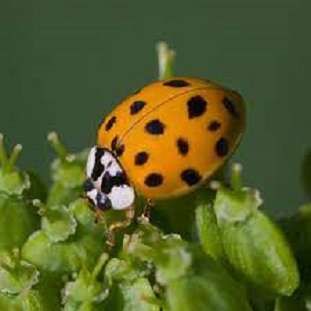SCORES & OUTDOORS: The lady beetles seem to be everywhere
 by Roland D. Hallee
by Roland D. Hallee
All of a sudden, there they were. One was walking up the side of my computer monitor at work, the other, traversing across the top of my steering wheel on my home from work later that day. And finally, on the east side of my house, in the windows, the following morning at sunrise.
Lady beetles, ladybugs, or ladybird beetles are among the most visible and best known beneficial predatory insects. Over 450 species are found in North America. Some are native and some have been introduced from other countries.
Just to set the record straight, they are not bugs, but beetles.
Most lady beetles in North America are beneficial as both adults and larvae, feeding primarily on aphids. They also feed on mites, small insects, and insect eggs. The two exceptions are the introduced Mexican bean beetle, and the squash beetle. The adults and larvae of both species feed on plants.
Lady beetles are usually red or orange with black markings. Some lady beetles are black, often with red markings. They have alligator-like larvae.
Many crops benefit from lady beetles. They are helpful for growers of vegetables, grain crops, legumes, strawberries, and tree crops; however any crop that is attacked by aphids will benefit from these beetles.
Most lady beetles found on crops and in gardens are aphid predators. Some species prefer only certain aphid species while others will attack many aphid species on a variety of crops. Some prefer mite or scale species. If aphids are scarce, lady beetle adults and larvae may feed on the eggs of moths and beetles, and mites, thrips, and other small insects, as well as pollen and nectar. They may also be cannibalistic. Because of their ability to survive on other prey when aphids are in short supply, lady beetles are particularly valuable natural enemies.
Adult lady beetles are small, round to oval, and dome-shaped. The most well known have black markings on red, orange, or yellow forewings, but some are black. The area immediately behind the head, the pronotum, may also have a distinctive pattern. The color and pattern of markings for each species may vary, but can aid identification.
Lady beetles overwinter as adults, often in aggregations along hedgerows, beneath leaf litter, under rocks and bark, and in other protected places including buildings. In spring, the adults disperse in search of prey and suitable egg laying sites. This dispersal trait, especially strong in migratory species such as the commercially available convergent lady beetle, can affect the reliability of control by released adult beetles.
Lady beetles are voracious feeders and may be numerous where prey are plentiful and broad-spectrum insecticide use is limited. Lady beetles need to eat many aphids per day so that they can lay eggs. The convergent lady beetle may eat its weight in aphids every day as a larva and consume as many as 50 aphids per day as an adult. Sevenspotted lady beetle adults may consume several hundred aphids per day and each larva eats 200 to 300 aphids as it grows. Once the adults and larvae have eliminated an aphid colony, they will search for additional food.
Lady beetles are effective predators if aphids are abundant (high pest density) but are thought to be less effective at low pest densities. There may also be some crop damage before lady beetles have an impact on an aphid population.
Most lady beetle species are active from late spring to early fall if food is available. Lady beetles are mobile as adults and reasonably so as larvae, and they are generalists. They will not remain on a plant, or in the vicinity, once the readily accessible prey has been consumed.
Early season populations of some lady beetles may develop on aphid-infested perennials or shrubs. Collection and redistribution of lady beetles is effective but time consuming. The beetles should be handled gently and placed in groups at the base of plants, rather than broadcast. Hibernating adults, congregating in protected spaces, should not be disturbed as they are vulnerable to attack by predators and parasitoids if uncovered.
Roland’s trivia questionn of the week:
Name the four NFL franchises to have never appeared in a Super Bowl.
Responsible journalism is hard work!
It is also expensive!
If you enjoy reading The Town Line and the good news we bring you each week, would you consider a donation to help us continue the work we’re doing?
The Town Line is a 501(c)(3) nonprofit private foundation, and all donations are tax deductible under the Internal Revenue Service code.
To help, please visit our online donation page or mail a check payable to The Town Line, PO Box 89, South China, ME 04358. Your contribution is appreciated!



Leave a Reply
Want to join the discussion?Feel free to contribute!